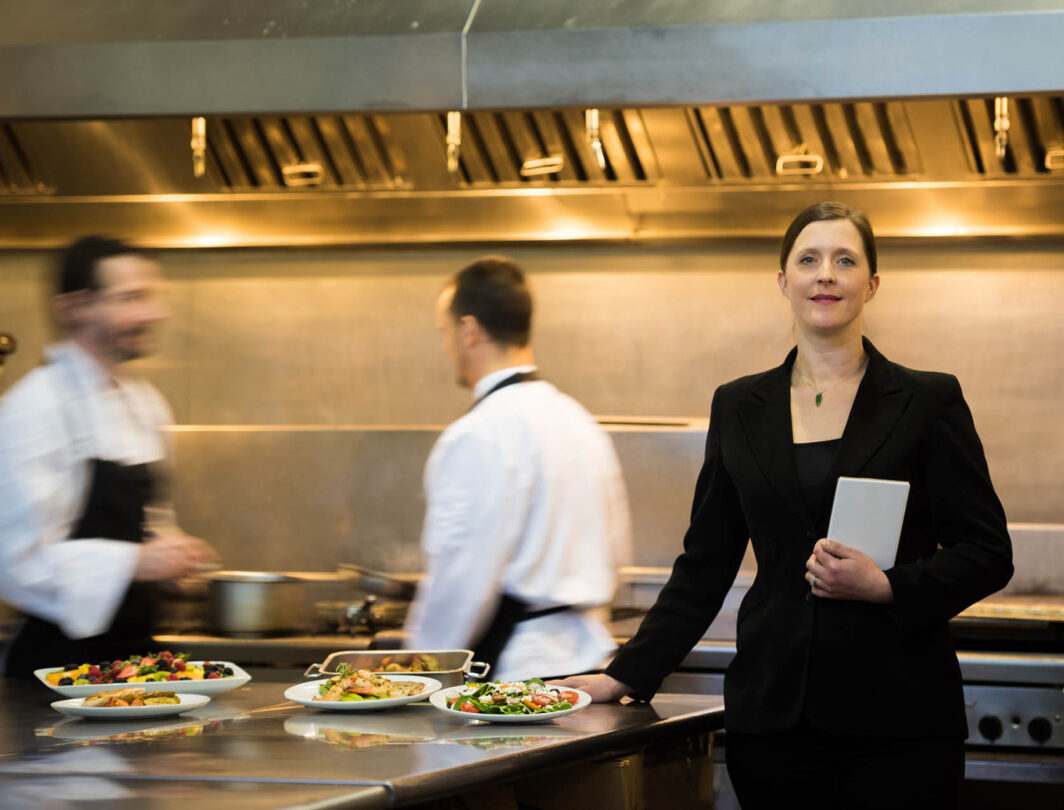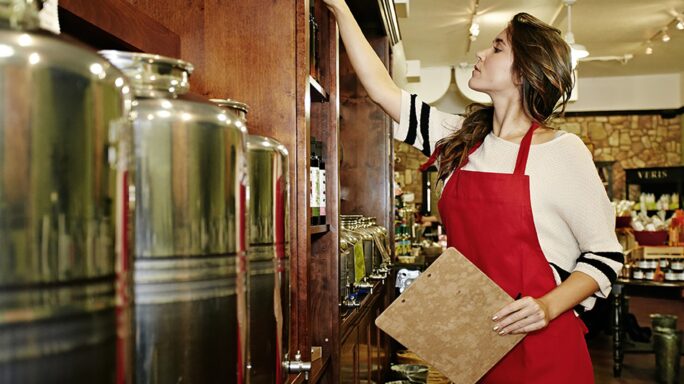Money Matters
How to cook up a winning restaurant business plan

Dreaming of being the next Angela Hartnett or Gordon Ramsay? Got a knack for whipping up mouthwatering meals? Want to turn your culinary expertise into a fledgling business?
There’s probably plenty of reasons why you’d want to open your own restaurant. But making it a success takes hard work and excellent execution.
Opening a new restaurant also requires careful planning. There’s lots to consider and do, from ordering stock and preparing meals to managing staff and keeping customers happy.
Having a restaurant business plan in place, which you review and update regularly as your company grows, will help you stay on track.
Learn how to develop your business idea into a multi-year strategy by following our business plan guide.
Here’s what we cover:
How to create your own restaurant business plan
Example of an executive summary
Consider ecommerce for an additional revenue stream
Final thoughts on creating a restaurant business plan
How to create your own restaurant business plan
From figuring out budgets and bringing investors on board to jargon-riddled forms, estimating figures, managing deadlines, suppliers, staff and more, launching and running your own restaurant is no piece of cake.
With household spending on restaurants and takeaways maintaining a steady foothold despite the pandemic, and business optimism hitting its highest levels since 2015, entrepreneurs across the UK are starting to take tentative steps into the hospitality sector again.
A recent poll of roughly 1,400 firms found that hotels and restaurants have moved to the most confident sector following a less positive outlook last autumn. Source: The Accenture/IHS Markit business outlook
The journey is as challenging as it is rewarding, so having a business plan for your restaurant on hand to keep you on track is a must.
You need to show that this is no pipedream; you’ve thought about and planned out every facet of your business-to-be, right down to what’s on the menu.
You’ve considered how ongoing restrictions might impact your business.
And as far as revenue goes, you’ve predicted what the restaurant will bring in over the first three, six and 12 months to the first few years in operation.
The pandemic completely transformed the way we live and work, so it comes as no surprise that any plans you put together need to take the new normal into account.
Post-coronavirus, businesses need to show that they’re more agile and prepared for the unexpected.
And you can do that by keeping a watchful eye over the latest health and safety guidance, and by making sure you keep your ecommerce capabilities high up on the priority list.
Your one stop shop for starting a business
Thinking about starting a business or already putting your ideas into action? We’ve got the resources, expertise and software to help you achieve your goals.

Getting started
Taking the time to organise your ideas down on paper will help you identify any hang-ups before you speak to potential collaborators or investors.
As you think and type, you’ll be able to spot any gaps or inconsistencies in your plan and anticipate (and answer) questions from your reader before doubts have time to form in their mind.
To help free your inner writer, start off by looking at as many successful businesses as you can with an analytical eye to get a flavour of what others have done to secure funding.
Draw inspiration from your favourite places to eat and drink and take note of things that have put you off from returning other venues in the past.
And remember, this document isn’t just something you draft up once and forget about.
As your ideas and your business develop, update your plan and keep coming back to it for guidance. Treat it as an anchor point when you’re faced with difficulties or aren’t quite sure which step to take next.
This is the roadmap to turning your culinary dream into a tasty reality.
Executive summary
Just like your starters, your executive summary needs to whet the appetite without going into too much detail – so keep it brief.
Give the reader enough information to want to know more about your idea, but not so much that they’ll feel overwhelmed by it all.
The aim here is to get your reader hooked and have them feeling hungry to find out more and read the rest of your restaurant business proposal.
Touch on the type of service you’d like to offer, what kind of cuisine you’ll be serving up, and what makes your business stand out against the competition.
Outline your relevant experience in the industry, and how it’s helped to inform your vision for this venture.
Make the most of the limited space and time you have here to grab the reader’s attention.
Consider getting the cover page branded up, incorporating your logo and brand colours, for instance. If you can get readers curious about this hypothetical establishment, then you’re one step closer to getting the cash you need to get cooking.
Example of an executive summary
To help you create an effective executive summary, here’s a fictional example to give you food for thought.
The opportunity
Newcastle city centre is an entertainment hub, with a fantastic range of shops, bars, restaurants, and cafes available for anyone to enjoy.
What’s missing, however, is a real steakhouse offering good, honest, organic food and casual dining at a reasonable price point. That’s where MOO comes in.
Why us?
MOO is the place to be if you’re looking for quality steaks, grass-fed and locally sourced right here in the UK. We pride ourselves on offering friendly, efficient service, and provide all our employees with in-depth training on all our ingredients and menu items.
Our branding and interiors reflect our commitment to fresh, organic ingredients, with a light, airy feel and grass motifs used throughout the space.
We only work suppliers who share our passion for sustainable foods, and craft seasonal menus bursting with fresh, organic ingredients.
Our bar is stocked with a great range of drinks, including craft beers and small-batch wines from independent brewers and vineyards.
It’s important to us that we use our success to support other small businesses doing great work.
The team
Phoebe Zanin is a chef with 12 years’ experience in the culinary sphere.
Phoebe started her career as a waitperson in her local pub before her passion for food led her to study at Apicius International School of Hospitality in Italy, where she met Tommaso, who specialises in restaurant management and is in charge of front of house at MOO.
The market
When it comes to entertainment, the outlook for Newcastle is distinctly positive.
We’ve seen significant investment in the city’s transport links and infrastructure over the past year, making it easier than ever for people to spend a day or night indulging in everything the Toon has to offer.
Competition
Our biggest competition is Robson & Red’s, located 10 minutes away from Central Station and offering a fine dining menu that isn’t exclusive to meat.
In terms of price, Robson & Red’s is on the higher end of the scale, while we’re looking to turn a respectable profit while making our establishment as accessible as possible.
The space we’re looking to acquire is located near Grey’s Monument, right in the heart of Newcastle.
Average footfall is high at both lunch and dinner time, with a prominent storefront and large windows providing a great view into the restaurant.
Market analysis
You can’t open any kind of business without first taking an in-depth look at the market you want to succeed in.
Enter market analysis.
Here, you’ll talk about the why behind your concept and really show your reader that you’ve done the research you need to set yourself up for success.
Start by asking yourself a few questions:
- Are there any businesses offering a similar experience? If not, why?
- Is there a gap in the market? What unique selling points (USPs) can you bring to fill it?
- Who is your target audience? Dig into their needs, preferences and priorities.
- Where will you be based? What’s the daily footfall like, and is it a tourist hot spot? If there are any offices in the area, there might be an opportunity to catch the lunchtime crowd.
- Who are your competitors and which suppliers do they use?
- How would coronavirus restrictions impact your business? Do you have a plan in place to keep your staff and your customers safe?
- How many covers could you accommodate if you have to follow social distancing rules, and would that be enough to sustain your business? Have you considered ecommerce opportunities?
Use this section to figure out why someone would and should choose your restaurant over anyone else in the area.
What do you bring to the table? What does your establishment offer that others don’t? What do you do better than most?
When talking about your target demographic – your ideal customer – be as thorough in your analysis as you possibly can.
Include all the demographic information you can, including age, household income, expectations, and values.
The clearer a snapshot you can get, the better you can cater for your customers and create a space that keeps them coming back for seconds. And thirds. And fourths. You get the idea.
Type of service
This is where you talk about the way you approach customer experience at your establishment.
While this is perhaps more relevant to fine dining restaurants and venues with unique service concepts, it’s certainly worth your time to give the reader a taste of what customers can expect, and your overall approach to hospitality.
“Follow your gut. It’s frequently the case that someone ‘doesn’t get it’ because it hasn’t been done. Don’t let their muted vision or imagination temper yours.” Angus Pride, managing partner, Peru Perdu
This is also the perfect opportunity to talk about the ecommerce side of things.
Do you offer a delivery service? Do platforms such as Uber Eats, Deliveroo and Just Eat fit into your plan? Could you offer a made-to-order service?
Beyond that, some the most popular types of service out there are:
- Family style
- Pre-plated/American
- Buffet
- Gueridon (trolley)
London-based wine retailer Vagabond Wines, for example, has a unique way of serving its customers, with self-service machines ready to pour a taster or full glass of any of the more than 100 wines available.
Each wine comes with tasting notes, making it easier than ever for wine novices and aficionados alike to get the most out of the experience.
If, like Vagabond Wines, your service style is something of a USP for your business, go to town.
But if it’s not a particularly important part of your concept, keep it concise while making it clear that you’ve thought about the customer experience side of things.
You might even want to include this in your introduction/concept instead over dedicating a specific section to it.
Consider ecommerce for an additional revenue stream
Ecommerce presents an incredible opportunity for you to fatten your margins, broaden your brand awareness and boost your marketing activities. So be deliberate about making this a core part of your strategy.
People can enjoy your food in the comfort of their home, and your name is kept fresh in their memory even when it’s not possible for customers to physically visit your venue.
Ecommerce also allows you to effectively increase covers without actually needing more seats and full team to accommodate it.
So why not give it a try?
In the early days, ecommerce was something of a daunting task. But in recent years it’s become surprisingly easy to get any business set up with an online store front.
Online payments are more secure and straightforward than ever before, and you can offer a streamlined takeaway menu to ensure the kitchen is not overwhelmed.
Consider merchandise options if they seem appropriate to your brand.
You could, for example, sell your signature chutneys and condiments in branded jars for people to enjoy at home. And what about the likes of branded tote bags or aprons, for example?
Throughout the pandemic, some businesses created a DIY version of their most popular dishes.
Newcastle-based eatery Meat:Stack, for instance, released its ‘Stack At Home’ kits to increase its ecommerce offering and add an element of fun through customer participation.
What foodie doesn’t want to have the opportunity to make restaurant-quality dishes at home?
Having this idea baked into your plan from day one will leave you better prepared for the unexpected, and will show potential investors that you’ve really considered every eventuality.
Bring the menu to life
No menu, no restaurant.
This is the heart of your business and central to your brand identity.
Take the time to plan and lay out a smart menu that not only captures the essence of what you’re all about, but is manageable for your kitchen to produce to a high standard on time, every time.
Use language that entices the reader and helps create a vivid mental picture of each dish – but be mindful that nobody wants to read an essay when they sit down to eat.
Don’t forget to include your bar options here too, particularly if you plan to have a dedicated bar area, where people might chat over a glass of wine and light snacks.
Design and layout
Don’t be afraid to include some visuals to help set the scene for potential investors.
Create a mood board to show the kind of aesthetic you’re going for in your restaurant business proposal and show your reader that you’ve given some serious thought to the layout and design of your space.
You could even provide a tentative floor plan to help illustrate how many seats you’ll have to make a certain number of covers, how that measures up against your overheads, and how people will be able to flow through the venue comfortably.
The layout of your restaurant impacts the way your front of house and back of house work together, as well as the safety of your patrons.
Show you’ve taken this into account by marking out a clear path that gives your wait staff easy access to all tables, and emergency exit points in case you need to evacuate.
Here, it might be worth bringing in a contractor to help you iron out the details according to the latest rules and regulations.
This might seem like a luxurious detail to add to a business plan but these factors do impact the overall customer experience as well as your bottom line.
The more easily your reader can picture themselves in your restaurant, the better.
The team
From servers to head chefs, sous chefs, sommeliers, bartenders and beyond, the team you build is as central to your success as your menu.
These are the people directly in contact with your customers on a day-to-day basis, whether that’s through the food they plate up or the greeting they give on arrival.
Having quality people on board is really crucial to your short and long-term success.
Give proper attention to the structure of your management team and make sure you have senior staff in place who can help you lead by example.
You might be starting out with something of a skeletal team, but it’s still important to provide a quick overview of you and your people, complete with experience in the industry and what you’ll each be in charge of on a day-to-day basis.
Things to consider include:
- How can you all contribute to the success of this business?
- How many employees will be working full time?
- How many employees will you bring in on a part-time basis?
When investors read your plan, they’re not just thinking about investing in your idea. They’re investing in the people behind it.
So it’s worth spending a good portion of time on this and showcasing your personalities, and what you add to the business.
Specialists and contractors
No matter where you are in your growth journey, there’s a good chance you’ll be bringing in some specialists and contractors on retainer, including:
- Accountants
- Legal counsel
- Designers
- Architects and interior designers
- Marketing specialists
- PR and outreach professionals.
Here, provide a quick overview of why you’ve chosen them and the particular services these contractors and specialists will provide.
Financials
In any new venture, you need to be able to account for every penny spent.
That’s not just to keep things organised and profitable, but to make sure you’re on top of everything from filing tax returns to keeping HMRC happy.
Keep (preferably digital) records of everything from the money that’s invested into your company to how much you spend, any assets or equipment owned, any debts you might owe, goods bought and sold, and how much stock you had at the end of the financial year.
Good cloud accounting software will help you stay on top of the financials for your restaurant.
When you’re preparing your business plan, sit down with your accountant (if you have one) and go through the finance side of things together.
Take into account all the costs of opening and running a restaurant, figure out how to minimise financial losses, and get a realistic budget in place.
And when it comes to budgeting, more is more. Leave a buffer for unexpected costs, such as emergency repairs or supply issues.
Work with an accountant who has experience in the restaurant and hospitality sector because they’ll be able to highlight the key financial points potential investors want to see, including a capital requirements budget, profit and loss statement for the initial three to five years, and a break-even analysis.
They’ll know what questions to ask you to get that information on paper, covering anything from the number of seats you’ll have and covers you’ll do each day to what the average bill will come to.
They’ll also be able to talk you through the ins and outs of cash flow and how that works for your restaurant.
Cash flow is basically the money moving in and out of your business over a specific amount of time.
Just because you’re turning a profit doesn’t mean you’ve got cash to spare. A good deal of your money might be tied up in pending invoices you need to pay your suppliers, for example.
Good cash flow management is the key to long-term success, covering everything from seasonal dips and ongoing costs to in-case-of-emergency situations that could otherwise bring your business to a halt.
While we’re on the topic of cash flow and finances, it’s worth looking into scalable, easy-to-use accounting software, even at this early stage.
This will allow you to manage your finances more effectively so you can spend less time worrying about admin and more time bossing your business.
The more your business grows, the more of a boon this will be.
Marketing and PR
According to Statista, nearly 30,000 new restaurants opened their doors in 2019.
Household spending on eating out is on the up. Even during lockdown, we’ve seen people ordering in from their favourite eateries, with restaurants and cafes across the country pivoting to expand their delivery offerings.
“Pre-launch, it’s about attracting new people. Ultimately, it’s about attempting to get people’s interests and I think social media is the best way to do it – so be consistent and drip-feed information rather than give it all at once to avoid losing the credibility to be interesting.” George Purnell, founder and managing director, Koop+Kraft
At the very least, you’ll need to show that you have a bare-bones strategy in place to market your business before and after launch.
Talk about your website, the different platforms you’ll use and why, and what media connections you have that can help you get the word out.
If you’re working with a marketing agency, share some details about them including some of their biggest clients and best-performing campaigns.
As with accountants, it’s worth going for an agency with extensive experience in the food and drink sector.
They’ll know what works and what doesn’t without wasting time and money on trial and error. Explain, in brief, your logic behind choosing this agency over others.
Final thoughts on creating a restaurant business plan
As you can see, there are a variety of elements to consider when you’re putting a business plan together for your restaurant.
But having this information in one place will help to give you the direction you need to ensure your business moves in the right direction.
From having a clear idea of who your customers are to how you’ll market your business and deal with the financials, good business planning will put you in good stead.
It’s worth highlighting that your business plan will change as your business progresses. You’ll probably find that your customer profiles, for example, could change as your restaurant develops.
That’s why it’s worth keeping your plan updated regularly. It will guide your decision making and keep you on track as your business grows.
And before you know it, you’ll be well on the way to becoming the next Angela Hartnett or Gordon Ramsay…
Business plan template for food and drink companies
Want to create a business plan for your food or drink company but not sure how to do it? Download our free and easy-to-use business plan template and you can get started.







Ask the author a question or share your advice